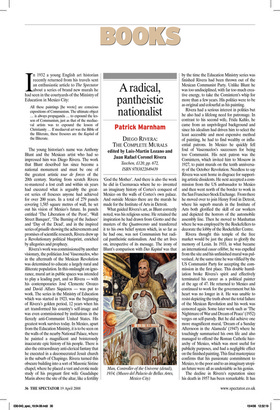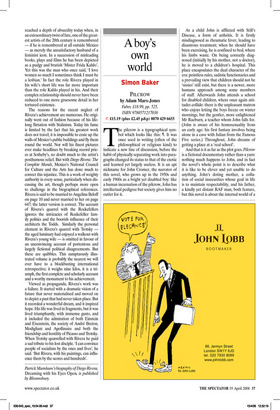BOOKS
A radical, pantheistic nationalist
Patrick Marnham
DIEGO RIvERA: THE COMPLETE MURALS edited by Luis-Martin Lozano and Juan Rafael Coronel Rivera Taschen, £120, pp. 672, ISBN 9783822849439 In 1932 a young English art historian recently returned from his travels sent an enthusiastic article to The Spectator about a series of brand new murals he had seen in the courtyards of the Ministry of Education in Mexico City: All these paintings [he wrote] are conscious expositions of Communism. The ultimate object ... is always propaganda ... to expound the lesson of Communism, just as that of the mediaeval artists was to expound the lesson of Christianity ... If mediaeval art was the Bible of the Illiterate, these frescoes are the Kapital of the Illiterate.
The young historian’s name was Anthony Blunt and the Mexican artist who had so impressed him was Diego Rivera. The work that Blunt described has since become a national monument and must be one of the greatest artistic tour de forces of the 20th century. Starting from scratch Rivera re-mastered a lost craft and within six years had executed what is arguably the greatest series of frescoes anyone had achieved for over 200 years. In a total of 279 panels covering 1,585 square metres of wall, he set out his vision of Mexico’s future. In panels entitled ‘The Liberation of the Peon’, ‘Wall Street Banquet’, ‘The Burning of the Judases’ and ‘Day of the Dead’, and in the inspired series of grisaille showing the achievements and promises of scientific research, Rivera drew up a Revolutionary political blueprint, enriched by allegories and prophecy.
Rivera’s work was commissioned by another visionary, the politician José Vasconcelos, who in the aftermath of the Mexican Revolution was determined to educate a largely rural and illiterate population. In this onslaught on ignorance, mural art in public spaces was intended to play a leading part, and so Rivera — with his contemporaries José Clemente Orozco and David Alfaro Siquieros — was put to work. The series in the Ministry of Education which was started in 1923, was the beginning of Rivera’s golden period, 12 years when his art transformed his country’s self-image and was even commissioned by institutions in the fiercely anti-Communist United States. His greatest work survives today. In Mexico, apart from the Education Ministry, it is to be seen on the walls of the nearby National Palace, where he painted a magnificent and boisterously inaccurate epic history of his people. There is also the extraordinary anti-clerical fantasy that he executed in a deconsecrated Jesuit church in the suburb of Chapingo. Rivera turned this obscure building into a sort of Masonic Sistine chapel, where he placed a vast and erotic nude study of his pregnant first wife Guadalupe Marin above the site of the altar, like a fertility ‘God the Mother’. And there is also the work he did in Cuernavaca where he reinvented an imaginary history of Cortes’s conquest of Mexico on the walls of Cortes’s own palace. And outside Mexico there are the murals he made for the Institute of Arts in Detroit.
What guided Rivera’s art, as Blunt correctly noted, was his religious sense. He retained the inspiration he had drawn from Giotto and the masters of the Quattrocento and transferred it to his own belief system which, in so far as he had one, was not Communism but radical pantheistic nationalism. And the art lives on, irrespective of its message. The irony of Blunt’s comparison with Das Kapital was that by the time the Education Ministry series was finished Rivera had been thrown out of the Mexican Communist Party. Unlike Blunt he was too undisciplined, with far too much creative energy, to take the Comintern’s whip for more than a few years. His politics were to be as original and colourful as his painting.
Rivera had a serious interest in politics but he also had a lifelong need for patronage. In contrast to his second wife, Frida Kahlo, he came from an unprivileged background and since his idealism had driven him to select the least accessible and most expensive method of painting, he had to find wealthy or influential patrons. In Mexico he quickly fell foul of Vasconcelos’s successors for being too Communist. His next patron was the Comintern, which invited him to Moscow in 1927, to paint murals on the tenth anniversary of the October Revolution. Needless to say Rivera was sent home in disgrace for supporting artistic dissidents. He next accepted a commission from the US ambassador to Mexico and then went north of the border to work in the San Francisco Stock Exchange. From there he moved over to join Henry Ford in Detroit, where his superb murals in the Institute of Arts both glorified the skill of car workers and depicted the horrors of the automobile assembly line. Then he moved to Manhattan where he was employed by the Rockefellers to decorate the lobby of the Rockefeller Centre.
Rivera thought this temple of the free market would be just the place to glorify the memory of Lenin. In 1933, in what became an international cause célèbre, he was expelled from the site and his unfinished mural was pulverised. At the same time he was vilified by the US Communist Party for accepting the commission in the first place. This double humiliation broke Rivera’s spirit and effectively terminated his career as a political painter at the age of 47. He returned to Mexico and continued to work for the government but his heart was no longer in it. He was unable to resist depicting the truth about the total failure of the Mexican Revolution and his work was censored again. Some later work such as ‘The Nightmare of War and Dream of Peace’ (1952) verges on self-parody. But he did achieve one more magnificent mural, ‘Dream of a Sunday Afternoon in the Alameda’ (1947) where he touchingly summarised his own life and also managed to offend the Roman Catholic hierarchy of Mexico, which was most useful for publicity purposes, and had a negligible effect on the finished painting. This final masterpiece confirms that his passionate commitment to Mexico, to the poor and to an imaginary utopian future were all as undeniable as his genius.
The decline in Rivera’s reputation since his death in 1957 has been remarkable. It has reached a depth of absurdity today when, in an extraordinary twist of fate, one of the greatest artists of the 20th century is remembered — if he is remembered at all outside Mexico — as merely the unsatisfactory husband of a feminist icon. In a succession of misleading books, plays and films he has been depicted as a pudgy and brutish ‘Mister Frida Kahlo’. Yet this was the man who once said, ‘I love women so much I sometimes think I must be a lesbian.’ In fact the role Rivera played in his wife’s short life was far more important than the role Kahlo played in his. And their complex relationship should never have been reduced to one more gruesome detail in her tortured existence.
The reasons for the recent neglect of Rivera’s achievement are numerous. He originally went out of fashion because of his lifelong flirtation with Stalinism. Today his fame is limited by the fact that his greatest work does not travel; it is impossible to crate up the walls of Mexico’s public buildings and fly them round the world. Nor will his finest pictures ever make headlines by breaking record prices at Sotheby’s, no doubt much to the artist’s posthumous relief. But with Diego Rivera: The Complete Murals, Mexico’s National Council for Culture and the Arts has done much to correct this injustice. This is a work of weighty authority in every sense, particularly when discussing the art, though perhaps more open to challenge in the biographical references. Rivera is said to be married to Angelina Beloff on page 10 and never married to her on page 647; the latter version is correct. The account of Rivera’s quarrel with the Rockefellers ignores the intricacies of Rockefeller family politics and the boorish influence of their architects the Todds. Similarly the personal element in Rivera’s quarrel with Trotsky — the aged luminary had enjoyed a walkout with Rivera’s young wife — is omitted in favour of an unconvincing account of portentous and largely fictional political disagreements. But these are quibbles. This sumptuously illustrated volume is probably the nearest we will ever have to a blockbusting international retrospective; it weighs nine kilos, it is a triumph, the first complete and scholarly account and a worthy monument to his achievement.
Viewed as propaganda, Rivera’s work was a failure. It started with a dramatic vision of a future that never materialised and moved on to depict a past that had never taken place. But it recorded a wonderful dream, and it inspired hope. His life was lived in fragments, but it was lived triumphantly, with immense gusto, and it included the admiration of both Einstein and Eisenstein, the society of André Breton, Modigliani and Apollinaire and both the friendship and hostility of Picasso and Trotsky. When Trotsky quarrelled with Rivera he paid a sad tribute to his lost disciple. ‘I can convince people of socialism by the ones and fives’, he said. ‘But Rivera, with his paintings, can influence them by the scores and hundreds’.



















































































 Previous page
Previous page